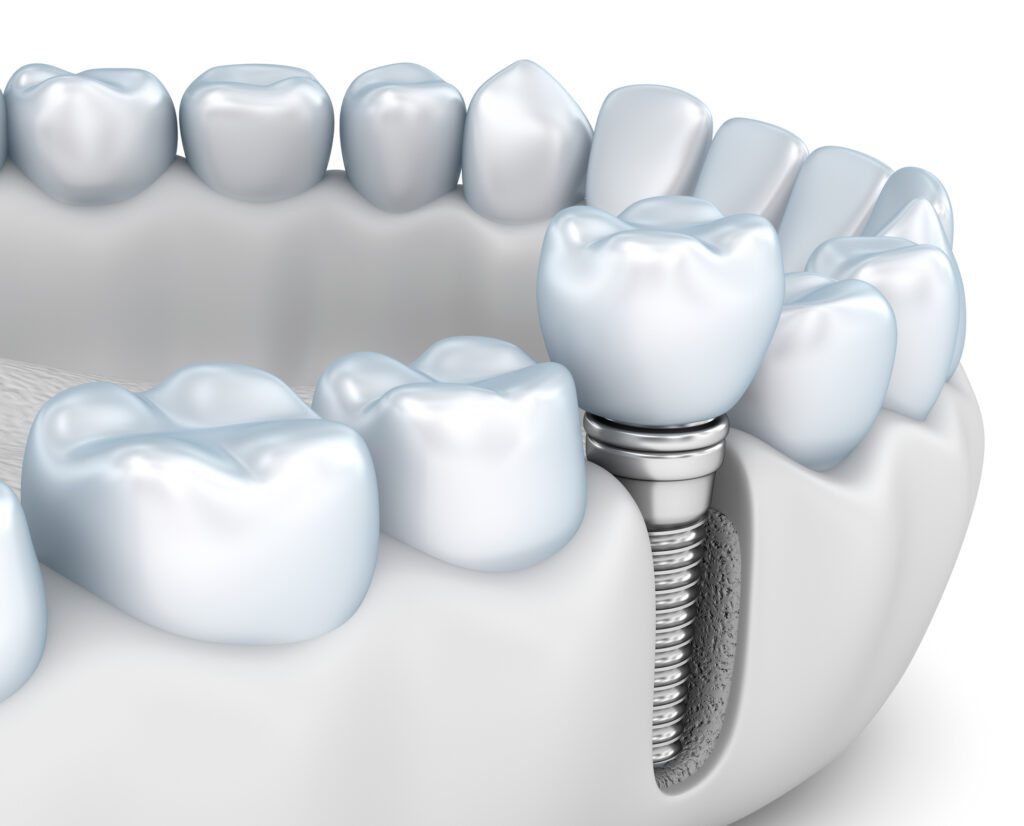Getting an implant can be a little anxiety-producing, especially since it requires surgery. But a single dental implant in Palmdale, CA, can help you retain jaw bone density, strengthen your bite, and improve the look of your smile. Missing teeth can cause a host of problems in your mouth without proper treatment. The dental implant process does take a while, but it’s worth it to help increase your overall oral health.

The Steps for a Single Dental Implant in Palmdale, CA
Everyone’s mouth is different, and no two implant treatment plans will look exactly the same. From initial consultation to completed treatment, it often takes a few months, with a majority of the time spent healing from surgery.
Potential Pre-Steps
In order to get a dental implant, your gums, jaw, and neighboring teeth need to be healthy. If there are any concerns of decay or damage, you’ll likely need some pre-treatment steps before you can successfully get a single dental implant. The two most common steps often needed are bone grafting and periodontal treatment.
Bone grafting is often required for patients who have suffered bone retention loss in the jaw. Implants are surgically placed in the jaw and integrate into the bone. If you don’t have enough bone density, the implant could fail.
Periodontal treatment is often needed for patients who suffer from gum disease. If the tissue of your gums isn’t healthy and strong, the implant could fail or cause further damage to your mouth.
Implant Placement
Once any pre-treatment is complete, your mouth is ready for the implant to be placed. This process does require surgery, in which anesthesia is used to reduce pain and discomfort. Your dentist surgically places a post in your missing tooth’s socket. This post is designed to mimic the natural root structure of a tooth for optimum bite strength and jaw health.
Healing
Surgery can be taxing on your body, and your mouth will naturally need a few days to heal. But even after the pain and discomfort subsides, your jaw is still at work, making sure the implant is stable. It can take around three to six months before a dental implant is properly integrated into your mouth. Attempting to perform any further treatment before the implant is secured could result in damage.
Restoration
After your dentist confirms that your implant is properly placed, they can begin the process of restoring it. Dental implants alone are just the root of your tooth. They also need an abutment and restorative treatment to complete your smile and bite. The most common restoration for a single dental implant is a dental crown. Your dentist will place the abutment and take an impression to ensure the crown fits neatly into your smile.
Frequently Asked Questions
Is getting a dental implant painful during or after the procedure?
The implant procedure isn’t painful because your dentist will completely numb the area. You might feel some pressure but not pain. After the procedure, mild soreness or swelling is common for a few days. Most people manage it easily with over-the-counter pain medicine.
What kind of anesthesia or sedation is used for implant surgery?
Local anesthesia is the most common option—it numbs the area while you stay awake. If you’re anxious, your dentist may offer sedation, like nitrous oxide or oral medication, to help you relax. For more complex cases, IV sedation may be used. Your dentist will recommend what’s safest and most comfortable for you.
How do I know if I have enough bone for a dental implant?
Your dentist will take X-rays or a 3D scan to check your bone height, width, and density. Bone loss is common if you’ve been missing a tooth for a while. In those cases, you may need a bone graft to build up the area before the implant is placed. Your dentist will walk you through the options.
What makes a dental implant better than a dental bridge for one missing tooth?
A tooth implant replaces the missing tooth without affecting the nearby teeth. Bridges require grinding down healthy teeth to support the restoration. Implants also help preserve bone and last longer with proper care. They look and feel more like natural teeth and don’t rely on other teeth for support.
How strong is a dental implant compared to a natural tooth?
A dental implant is very strong—similar to a natural tooth in function and durability. It’s anchored in the jawbone, just like a real tooth root, which gives it stability. It can handle normal chewing and biting without a problem with good care. Implants are designed to last for decades.
How long does the crown on the implant last?
The crown on a dental implant usually lasts 10 to 15 years, sometimes longer. Its lifespan depends on how well you care for it—brushing, flossing, and regular checkups are key. If it wears down or chips, it can be replaced without removing the implant itself. The implant post often lasts a lifetime.
At Premier Dental Care, we are a full-service implant office. Everything from bone grafting to a dental crown can be handled right from the comfort of our office. If you’re missing a tooth, call us today at (661) 231-7031 to schedule an appointment and learn more about implant dentistry.
